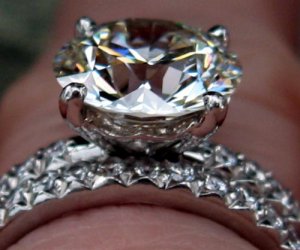wistletown
Rough_Rock
- Joined
- Feb 1, 2007
- Messages
- 51
EDIT************** I just called the Polar Bear company to see if they have more info. on this Canadian stone and the woman I spoke with told me bruted girdles are common with their stones. They do it for 2 main reasons 1) They believe their bruting process is good enough that they do not need to polish it and it's a cost effective decision and 2) The NWT enscription last longer on bruted girdles. She told me the diamond is excellent and it has an internal appraisal grade of 000, whatever that means.
Here's a little background information on the diamond before I begin:
Cut: Round Brillant
Measurements: 8.19X8.21X5.00mm
Carat: 2.01
Color: G
Clarity: VSI
Cut Grade: Very Good
Polish: Excellent
Symmetry: Excellent
Flourescence: None
Table: 56%
Depth: 61%
Crown Angle: 34.5 Degrees
Girdle: Thin - Medium
Pavillion Angle: 41 Degrees
Candian Polar Bear gov't certified diamond with NWT number engraved on the girdle.
Also under the table on the GIA certificate is this comment: Cut grade affected by brillanteering
I took this stone to an average appraiser (I wouldnt say they were good). The stone is set in a temporary setting for now. I just wanted an inexpensive appraiser for now to give me a bit of piece of mine the stone is real and all. After it's set in the actual setting I will bring it to a much more reputable appraiser. The appraiser did bring something to my attention. The girdle is unpolished. I've searched for unpolished bruted girdles on this forum and it's mentioned that this is only common with lhigher color grade diamonds such as (J,K) diamonds as well as very small stones.
My question is why would the cutter have chosen to do this with a G 2.0+ carat diamond? The stone is very shiny. All the proportions are good. Cost was $22,800ish. What do I have to worry about with an unfinished girdle? The price WAS a few grand lower than any price I can find for a diamond with similar specs. Did the unpolished girdle call for the lower price?
Please help.
Here's a little background information on the diamond before I begin:
Cut: Round Brillant
Measurements: 8.19X8.21X5.00mm
Carat: 2.01
Color: G
Clarity: VSI
Cut Grade: Very Good
Polish: Excellent
Symmetry: Excellent
Flourescence: None
Table: 56%
Depth: 61%
Crown Angle: 34.5 Degrees
Girdle: Thin - Medium
Pavillion Angle: 41 Degrees
Candian Polar Bear gov't certified diamond with NWT number engraved on the girdle.
Also under the table on the GIA certificate is this comment: Cut grade affected by brillanteering
I took this stone to an average appraiser (I wouldnt say they were good). The stone is set in a temporary setting for now. I just wanted an inexpensive appraiser for now to give me a bit of piece of mine the stone is real and all. After it's set in the actual setting I will bring it to a much more reputable appraiser. The appraiser did bring something to my attention. The girdle is unpolished. I've searched for unpolished bruted girdles on this forum and it's mentioned that this is only common with lhigher color grade diamonds such as (J,K) diamonds as well as very small stones.
My question is why would the cutter have chosen to do this with a G 2.0+ carat diamond? The stone is very shiny. All the proportions are good. Cost was $22,800ish. What do I have to worry about with an unfinished girdle? The price WAS a few grand lower than any price I can find for a diamond with similar specs. Did the unpolished girdle call for the lower price?
Please help.









300x240.png)